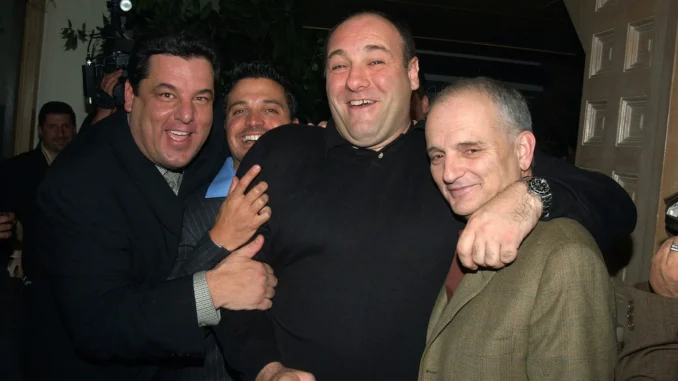
The ending of The Sopranos remains one of the most debated and analyzed conclusions in television history. Fans have speculated for years about what really happened in that infamous cut to black. Did Tony Soprano (James Gandolfini) meet his end, or did life carry on as usual? David Chase, the series creator, has slowly begun to peel back the layers of this enigma, recently hinting that the keys to understanding the finale are embedded in earlier seasons, particularly Season 3.
The Tension of the Finale: A Family Dinner with a Twist
In the final moments of The Sopranos, we find Tony and his family sharing what appears to be an ordinary dinner at Holston’s. But the seemingly mundane scene is steeped in suspense. As the bell above the door chimes and various characters enter, including a suspicious-looking man in a Members Only jacket, the tension is palpable. Is Tony anxiously awaiting his daughter Meadow, or is he bracing for an attack?
Chase himself has described the ending as a “death scene,” but he often leaves it open to interpretation. His cryptic musings lead fans to wonder: does the abrupt cut signal Tony’s demise, or does it imply that life continues beyond that moment? Chase’s ambivalence about the ending only adds to the intrigue, inviting viewers to draw their own conclusions.
Clues Hidden in Season 3
Interestingly, Chase points to a seemingly innocuous exchange from Season 3 as a pivotal clue for the series finale. In the episode “Proshai, Livushka,” which revolves around Livia Soprano’s death, a conversation between A.J. (Robert Iler) and Meadow (Jamie Lynn Sigler) surfaces. A.J. is struggling to understand Robert Frost’s poem “Stopping By Woods on a Snowy Evening,” and he mistakenly believes that the color black represents death.
Meadow attempts to help her brother see beyond his literal interpretation, suggesting that snow symbolizes “endless nothing.” A.J., however, insists that black signifies death. This exchange stuck with Chase and, in the context of the finale, it reinforces the theme of uncertainty surrounding life and death.
The Artistic Choices Behind the Ending
Chase’s decision to cut to black isn’t just a dramatic flourish; it represents a deeper philosophical contemplation about existence. In the documentary Wise Guy, Chase reflects on his creative process, emphasizing how he used the moment to symbolize both an ending and an ongoing story. “The universe goes on and on,” he explains, suggesting that even if Tony’s journey ends, life and its complexities will persist.
By drawing a parallel between A.J.’s misunderstanding of the poem and Tony’s fate, Chase elegantly illustrates the ambiguity of both death and life. The decision to leave viewers hanging isn’t just about leaving Tony’s fate unclear; it’s about provoking thought and reflection on the nature of existence itself.
The Complexity of Tony’s Fate
The finale’s ambiguity reflects the intricacies of Tony’s character. Throughout the series, he is both a loving father and a ruthless mob boss, embodying conflicting aspects of morality. The dinner scene illustrates this duality—family warmth contrasted with the looming threat of violence. As viewers watch Tony’s family interact, it becomes evident that they are blissfully unaware of the potential danger, highlighting how life’s ordinary moments often exist alongside the specter of death.
Chase has shared that he didn’t want to depict Tony’s death graphically, much like how he chose not to show Adriana’s death in Season 6. “I couldn’t bear to see Adriana get shot,” he admitted. This emotional connection to his characters lends a personal touch to the storytelling, allowing viewers to feel the weight of these moments without needing to witness the brutality firsthand.
The Journey Continues: Reflections on Life and Legacy
As Chase delves deeper into the meaning behind the finale, he emphasizes that the show’s end doesn’t equate to the end of the characters’ stories. By using the Journey song “Don’t Stop Believin’” as the soundtrack to the final scene, he reinforces the idea that life, like the song, is an ongoing journey. “The movie never ends; it goes on and on,” he notes, encouraging viewers to consider the broader narrative beyond Tony’s life.
This sentiment resonates particularly well with fans who continue to engage with the series long after its conclusion. The Sopranos may have wrapped up its storylines, but the discussions it sparks endure. The complexity of Tony Soprano’s character and the moral dilemmas presented throughout the series ensure that it remains a topic of conversation and analysis.
Conclusion
David Chase’s reflections on The Sopranos finale reveal a nuanced understanding of life, death, and the human experience. By tying the end of the series to earlier moments in the show, especially the poignant exchange between A.J. and Meadow, he allows viewers to explore deeper meanings behind the cut to black. The finale invites us to ponder the fragility of life and the continuity of the universe, reminding us that while Tony Soprano’s story may have reached a cliffhanger, our own journeys continue.
